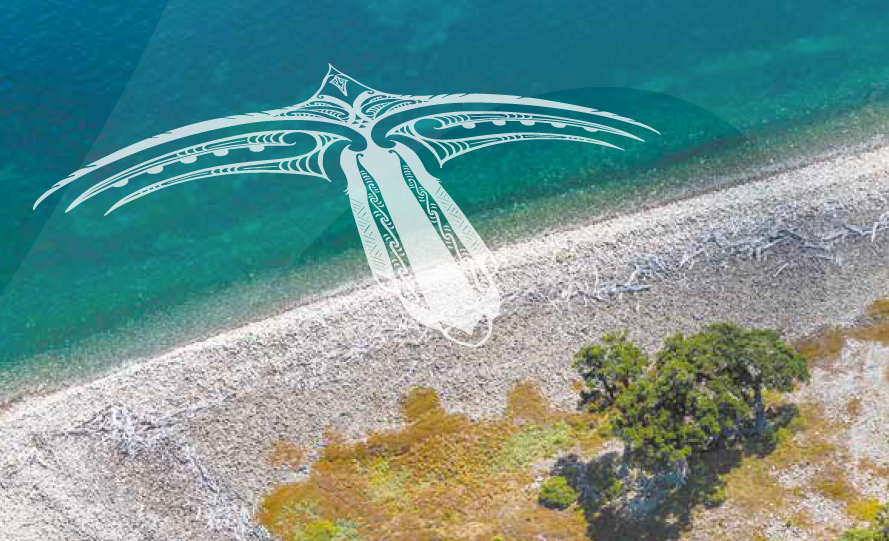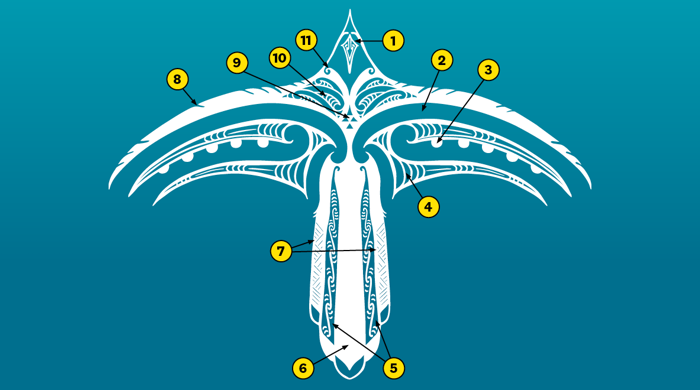
Te Haumanu Taiao - he kōrero mō Haumanu
Te Haumanu Taiao – about Haumanu
Learn more about the individual design elements that make up Haumanu - the bird-like symbol of kaitiakitanga.

Haumanu is symbolic of the manaakitanga for te taiao, the spiritual realm, keeping an eye on all we do and urging us to be mindful of the footprint we leave. It can be seen throughout Te Haumanu Taiao: Restoring the natural environment in Tāmaki Makaurau.
The tohu (graphic designs) that make up Haumanu were brought together by Hokimai-Anahera Rosieur of Ngāti Manuhiri, with the guidance and support of Ngā Iwi Mana Whenua o Tāmaki Makaurau and Auckland Council. They feature throughout the resource.
Kua eke te wā, me noho mātāmua ko te whakaaro nui ki te Taiao i ngā mahi katoa
No longer will things happen without consideration of the impact within te taiao
Nā Hokimai-Anahera Rosieur, Ngāti Manuhiri
The translucent design of Haumanu represents the tūpuna and the spiritual connection between the past and the present. Haumanu is symbolic of the role of kaitiaki and kaitiakitanga.
The intricate patterns within the design speak to the connection of people and the environment, that we are dependent and vulnerable if we do not look after one another.
Read more about Haumanu on page 3 of the resource.

The image of Haumanu shows the individual design elements, numbered from one to eleven.
Artist Hokimai-Anahera Rosieur explains what these mean:
- Ruahine
The ruahine (ancient pattern) speaks to the foresight and guidance from our tūpuna (ancestors), inspiring better outcomes and overcoming challenges for the current and future wellbeing of te taiao (the natural environment). - Puhoro
Represents the current, the waves of our moana – these reach from the tips of the wings towards the body. - Pītau
The pītau across each wing symbolise the young shoots of a fern representing Te Wao nui a Tāne. - Unaunahi
This pattern represents ‘ko te unaunahi I whakapiripiri ki te kia nui a maui’ - the great scales that clothe the fish of Maui (the North Island). - Translucent tail feathers
The two clear or translucent huia tail feathers either side of the middle tail feather represent wairua. One represents those tūpuna who advocated tirelessly to tiaki te taiao. The other represents ngāi kīrehe that are extinct, no longer in our landscape. The raperape pattern, repeated along these two feathers, is often related to the umbilical cord or the flow of life. Here it represents our awa, acknowledging water is life. - Middle huia tail feather
Represents the support of Ngā Iwi Mana Whenua o Tāmaki Makaurau. Together, the middle feathers represent the ground swell of collective effort required to transform te taiao to its natural and healthy state. The hope is that over time te taiao will need less intervention from people and be able to regenerate naturally. - Outer huia tail feathers
Represent leadership and the change we want to see for the environment, symbolised by using the feather of the huia. The outer feathers are also adorned with the harakeke pattern which acknowledges the weaving of people and the restoration of the environment. - Notches
The notches across the front of the span of both wings represent Ngā Iwi Mana Whenua o Tāmaki Makaurau. - Aramoana
This triangular design refers to supporting the mountains and the seas as pathways across the land to the sea. - Ngā koru tuarua
Layered ngaru acknowledge the term ‘rere ki uta, rere ki tai’ – from our mountains to the sea and from coast to coast. - Ngā koru tuatahi - tihi
Below the ruahine, flanked on both sides of the head are koru that represent our maunga – those that exist. The negative space of the spiral represents maunga that have been removed (quarried) and are no longer there.



